University Economics: Critical Review of Housing Affordability Article
VerifiedAdded on 2022/10/02
|5
|1473
|56
Essay
AI Summary
This assignment is a critical review of the article "Australian Housing Stuck between a rock and a hard place" by Grogs Gamut, focusing on housing affordability in Australia. The review summarizes the article's main points, which attribute housing unaffordability to factors like rising prices, income inequality, interest rates, and unrestricted lending. The student assesses the significance of these issues, agreeing on the importance of income and interest rates but also suggesting the need to consider other factors like government regulations and demand/supply dynamics. The review analyzes the author's arguments, finding them convincing regarding the impact of income and interest rates. The essay identifies the relevant macroeconomic concepts, such as income and interest rates, and comments on the accuracy of their application. Finally, it evaluates the article's writing quality and suggests improvements, such as including the role of government and demand/supply factors.
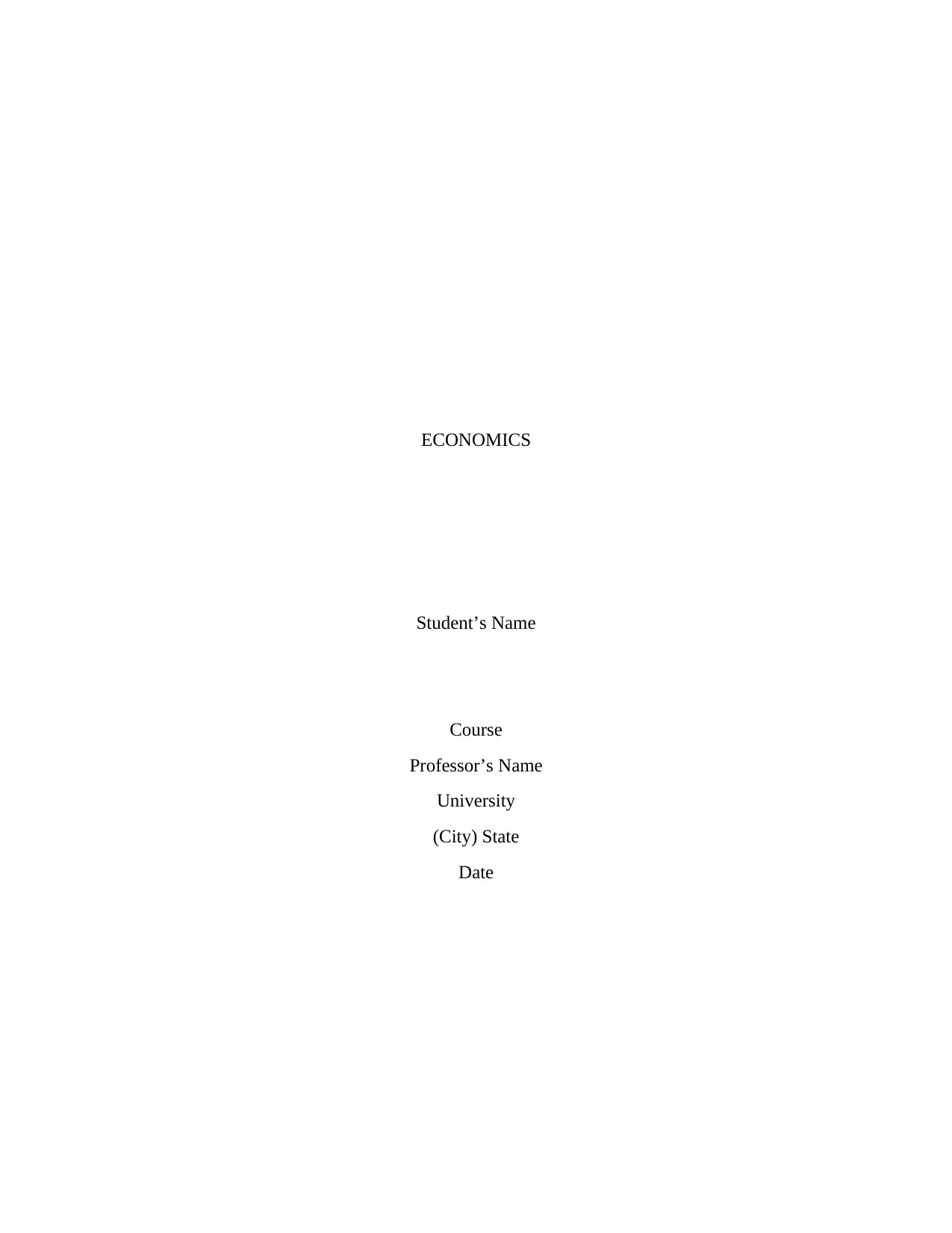
ECONOMICS
Student’s Name
Course
Professor’s Name
University
(City) State
Date
Student’s Name
Course
Professor’s Name
University
(City) State
Date
Paraphrase This Document
Need a fresh take? Get an instant paraphrase of this document with our AI Paraphraser
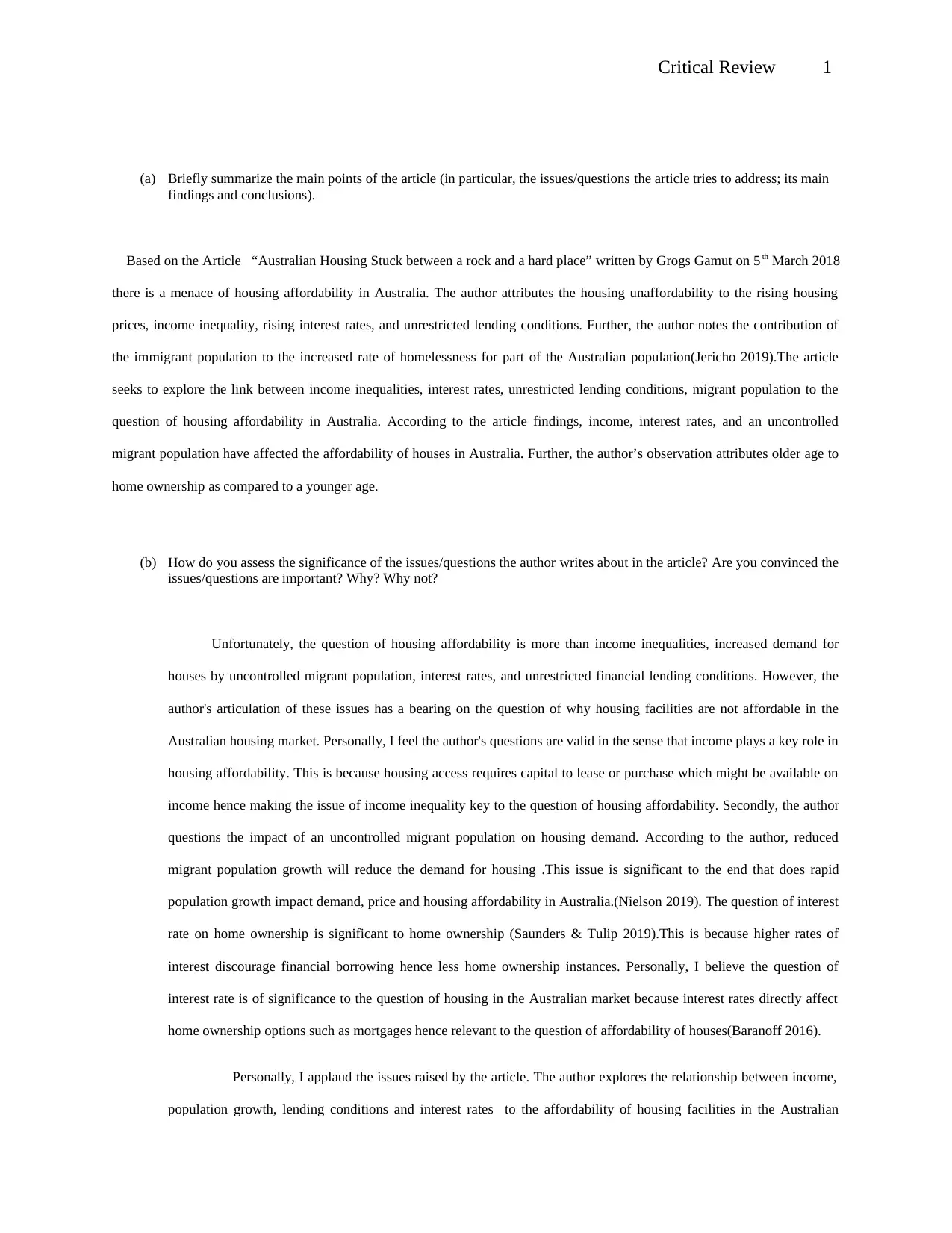
Critical Review 1
(a) Briefly summarize the main points of the article (in particular, the issues/questions the article tries to address; its main
findings and conclusions).
Based on the Article “Australian Housing Stuck between a rock and a hard place” written by Grogs Gamut on 5 th March 2018
there is a menace of housing affordability in Australia. The author attributes the housing unaffordability to the rising housing
prices, income inequality, rising interest rates, and unrestricted lending conditions. Further, the author notes the contribution of
the immigrant population to the increased rate of homelessness for part of the Australian population(Jericho 2019).The article
seeks to explore the link between income inequalities, interest rates, unrestricted lending conditions, migrant population to the
question of housing affordability in Australia. According to the article findings, income, interest rates, and an uncontrolled
migrant population have affected the affordability of houses in Australia. Further, the author’s observation attributes older age to
home ownership as compared to a younger age.
(b) How do you assess the significance of the issues/questions the author writes about in the article? Are you convinced the
issues/questions are important? Why? Why not?
Unfortunately, the question of housing affordability is more than income inequalities, increased demand for
houses by uncontrolled migrant population, interest rates, and unrestricted financial lending conditions. However, the
author's articulation of these issues has a bearing on the question of why housing facilities are not affordable in the
Australian housing market. Personally, I feel the author's questions are valid in the sense that income plays a key role in
housing affordability. This is because housing access requires capital to lease or purchase which might be available on
income hence making the issue of income inequality key to the question of housing affordability. Secondly, the author
questions the impact of an uncontrolled migrant population on housing demand. According to the author, reduced
migrant population growth will reduce the demand for housing .This issue is significant to the end that does rapid
population growth impact demand, price and housing affordability in Australia.(Nielson 2019). The question of interest
rate on home ownership is significant to home ownership (Saunders & Tulip 2019).This is because higher rates of
interest discourage financial borrowing hence less home ownership instances. Personally, I believe the question of
interest rate is of significance to the question of housing in the Australian market because interest rates directly affect
home ownership options such as mortgages hence relevant to the question of affordability of houses(Baranoff 2016).
Personally, I applaud the issues raised by the article. The author explores the relationship between income,
population growth, lending conditions and interest rates to the affordability of housing facilities in the Australian
(a) Briefly summarize the main points of the article (in particular, the issues/questions the article tries to address; its main
findings and conclusions).
Based on the Article “Australian Housing Stuck between a rock and a hard place” written by Grogs Gamut on 5 th March 2018
there is a menace of housing affordability in Australia. The author attributes the housing unaffordability to the rising housing
prices, income inequality, rising interest rates, and unrestricted lending conditions. Further, the author notes the contribution of
the immigrant population to the increased rate of homelessness for part of the Australian population(Jericho 2019).The article
seeks to explore the link between income inequalities, interest rates, unrestricted lending conditions, migrant population to the
question of housing affordability in Australia. According to the article findings, income, interest rates, and an uncontrolled
migrant population have affected the affordability of houses in Australia. Further, the author’s observation attributes older age to
home ownership as compared to a younger age.
(b) How do you assess the significance of the issues/questions the author writes about in the article? Are you convinced the
issues/questions are important? Why? Why not?
Unfortunately, the question of housing affordability is more than income inequalities, increased demand for
houses by uncontrolled migrant population, interest rates, and unrestricted financial lending conditions. However, the
author's articulation of these issues has a bearing on the question of why housing facilities are not affordable in the
Australian housing market. Personally, I feel the author's questions are valid in the sense that income plays a key role in
housing affordability. This is because housing access requires capital to lease or purchase which might be available on
income hence making the issue of income inequality key to the question of housing affordability. Secondly, the author
questions the impact of an uncontrolled migrant population on housing demand. According to the author, reduced
migrant population growth will reduce the demand for housing .This issue is significant to the end that does rapid
population growth impact demand, price and housing affordability in Australia.(Nielson 2019). The question of interest
rate on home ownership is significant to home ownership (Saunders & Tulip 2019).This is because higher rates of
interest discourage financial borrowing hence less home ownership instances. Personally, I believe the question of
interest rate is of significance to the question of housing in the Australian market because interest rates directly affect
home ownership options such as mortgages hence relevant to the question of affordability of houses(Baranoff 2016).
Personally, I applaud the issues raised by the article. The author explores the relationship between income,
population growth, lending conditions and interest rates to the affordability of housing facilities in the Australian
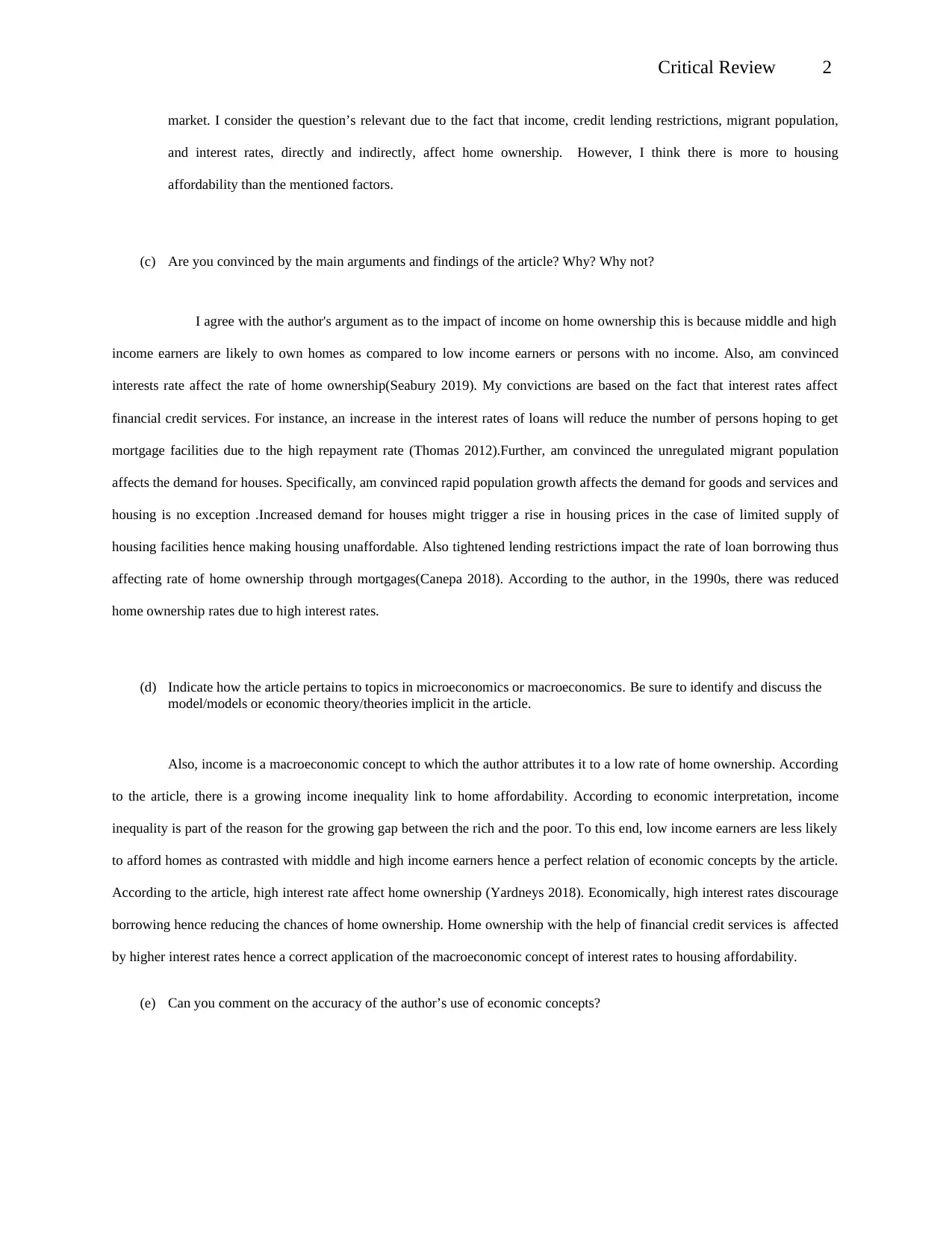
Critical Review 2
market. I consider the question’s relevant due to the fact that income, credit lending restrictions, migrant population,
and interest rates, directly and indirectly, affect home ownership. However, I think there is more to housing
affordability than the mentioned factors.
(c) Are you convinced by the main arguments and findings of the article? Why? Why not?
I agree with the author's argument as to the impact of income on home ownership this is because middle and high
income earners are likely to own homes as compared to low income earners or persons with no income. Also, am convinced
interests rate affect the rate of home ownership(Seabury 2019). My convictions are based on the fact that interest rates affect
financial credit services. For instance, an increase in the interest rates of loans will reduce the number of persons hoping to get
mortgage facilities due to the high repayment rate (Thomas 2012).Further, am convinced the unregulated migrant population
affects the demand for houses. Specifically, am convinced rapid population growth affects the demand for goods and services and
housing is no exception .Increased demand for houses might trigger a rise in housing prices in the case of limited supply of
housing facilities hence making housing unaffordable. Also tightened lending restrictions impact the rate of loan borrowing thus
affecting rate of home ownership through mortgages(Canepa 2018). According to the author, in the 1990s, there was reduced
home ownership rates due to high interest rates.
(d) Indicate how the article pertains to topics in microeconomics or macroeconomics. Be sure to identify and discuss the
model/models or economic theory/theories implicit in the article.
Also, income is a macroeconomic concept to which the author attributes it to a low rate of home ownership. According
to the article, there is a growing income inequality link to home affordability. According to economic interpretation, income
inequality is part of the reason for the growing gap between the rich and the poor. To this end, low income earners are less likely
to afford homes as contrasted with middle and high income earners hence a perfect relation of economic concepts by the article.
According to the article, high interest rate affect home ownership (Yardneys 2018). Economically, high interest rates discourage
borrowing hence reducing the chances of home ownership. Home ownership with the help of financial credit services is affected
by higher interest rates hence a correct application of the macroeconomic concept of interest rates to housing affordability.
(e) Can you comment on the accuracy of the author’s use of economic concepts?
market. I consider the question’s relevant due to the fact that income, credit lending restrictions, migrant population,
and interest rates, directly and indirectly, affect home ownership. However, I think there is more to housing
affordability than the mentioned factors.
(c) Are you convinced by the main arguments and findings of the article? Why? Why not?
I agree with the author's argument as to the impact of income on home ownership this is because middle and high
income earners are likely to own homes as compared to low income earners or persons with no income. Also, am convinced
interests rate affect the rate of home ownership(Seabury 2019). My convictions are based on the fact that interest rates affect
financial credit services. For instance, an increase in the interest rates of loans will reduce the number of persons hoping to get
mortgage facilities due to the high repayment rate (Thomas 2012).Further, am convinced the unregulated migrant population
affects the demand for houses. Specifically, am convinced rapid population growth affects the demand for goods and services and
housing is no exception .Increased demand for houses might trigger a rise in housing prices in the case of limited supply of
housing facilities hence making housing unaffordable. Also tightened lending restrictions impact the rate of loan borrowing thus
affecting rate of home ownership through mortgages(Canepa 2018). According to the author, in the 1990s, there was reduced
home ownership rates due to high interest rates.
(d) Indicate how the article pertains to topics in microeconomics or macroeconomics. Be sure to identify and discuss the
model/models or economic theory/theories implicit in the article.
Also, income is a macroeconomic concept to which the author attributes it to a low rate of home ownership. According
to the article, there is a growing income inequality link to home affordability. According to economic interpretation, income
inequality is part of the reason for the growing gap between the rich and the poor. To this end, low income earners are less likely
to afford homes as contrasted with middle and high income earners hence a perfect relation of economic concepts by the article.
According to the article, high interest rate affect home ownership (Yardneys 2018). Economically, high interest rates discourage
borrowing hence reducing the chances of home ownership. Home ownership with the help of financial credit services is affected
by higher interest rates hence a correct application of the macroeconomic concept of interest rates to housing affordability.
(e) Can you comment on the accuracy of the author’s use of economic concepts?
⊘ This is a preview!⊘
Do you want full access?
Subscribe today to unlock all pages.

Trusted by 1+ million students worldwide
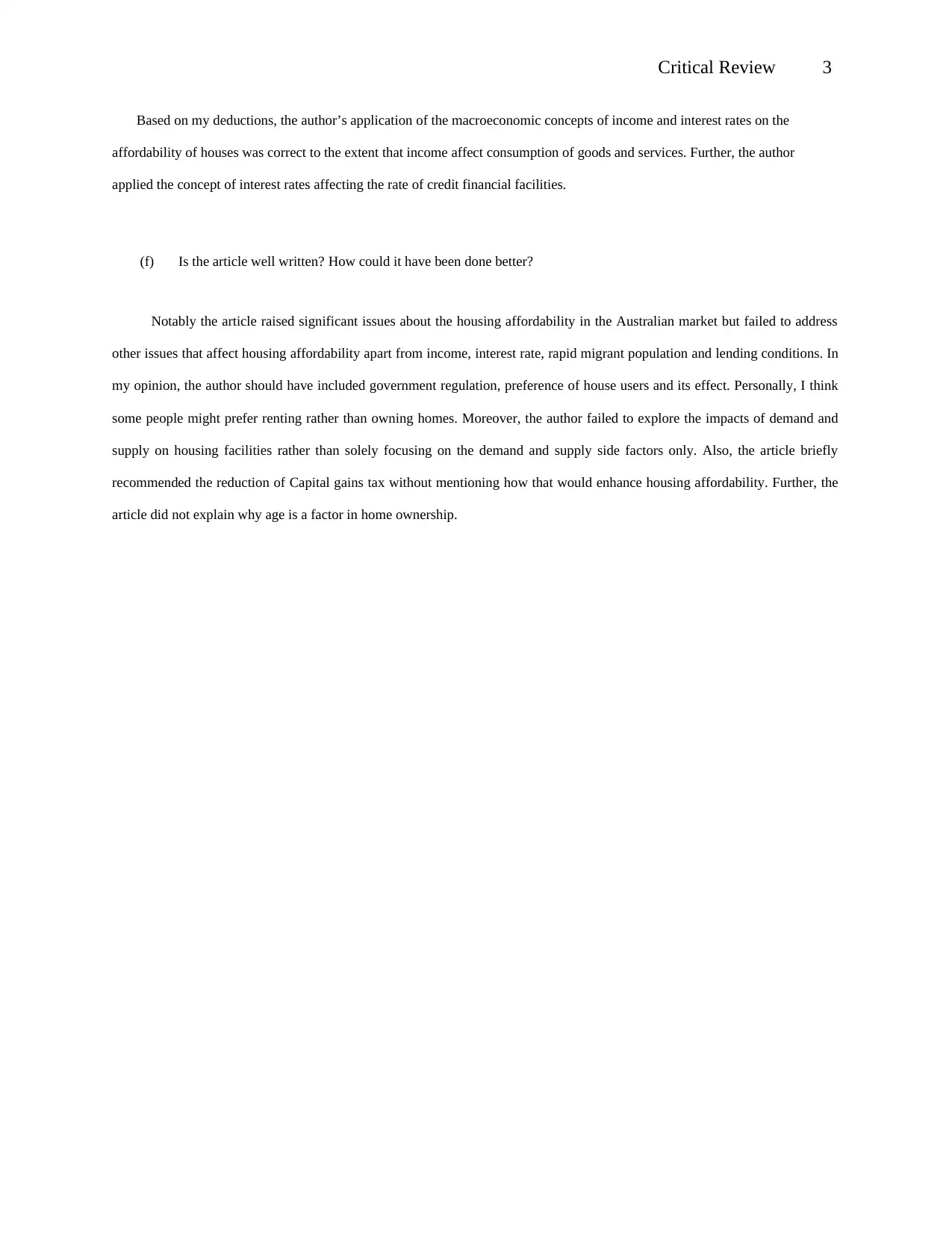
Critical Review 3
Based on my deductions, the author’s application of the macroeconomic concepts of income and interest rates on the
affordability of houses was correct to the extent that income affect consumption of goods and services. Further, the author
applied the concept of interest rates affecting the rate of credit financial facilities.
(f) Is the article well written? How could it have been done better?
Notably the article raised significant issues about the housing affordability in the Australian market but failed to address
other issues that affect housing affordability apart from income, interest rate, rapid migrant population and lending conditions. In
my opinion, the author should have included government regulation, preference of house users and its effect. Personally, I think
some people might prefer renting rather than owning homes. Moreover, the author failed to explore the impacts of demand and
supply on housing facilities rather than solely focusing on the demand and supply side factors only. Also, the article briefly
recommended the reduction of Capital gains tax without mentioning how that would enhance housing affordability. Further, the
article did not explain why age is a factor in home ownership.
Based on my deductions, the author’s application of the macroeconomic concepts of income and interest rates on the
affordability of houses was correct to the extent that income affect consumption of goods and services. Further, the author
applied the concept of interest rates affecting the rate of credit financial facilities.
(f) Is the article well written? How could it have been done better?
Notably the article raised significant issues about the housing affordability in the Australian market but failed to address
other issues that affect housing affordability apart from income, interest rate, rapid migrant population and lending conditions. In
my opinion, the author should have included government regulation, preference of house users and its effect. Personally, I think
some people might prefer renting rather than owning homes. Moreover, the author failed to explore the impacts of demand and
supply on housing facilities rather than solely focusing on the demand and supply side factors only. Also, the article briefly
recommended the reduction of Capital gains tax without mentioning how that would enhance housing affordability. Further, the
article did not explain why age is a factor in home ownership.
Paraphrase This Document
Need a fresh take? Get an instant paraphrase of this document with our AI Paraphraser
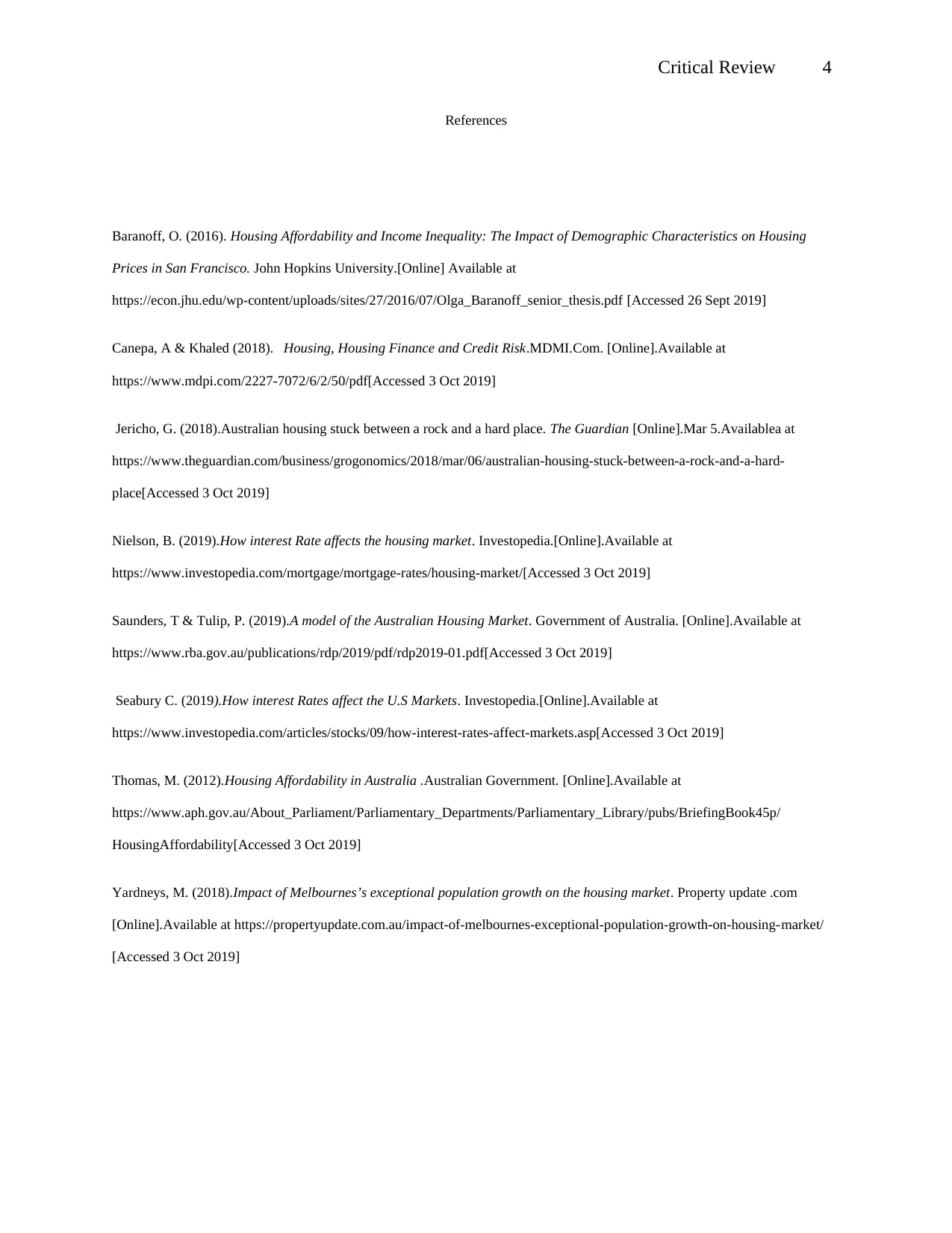
Critical Review 4
References
Baranoff, O. (2016). Housing Affordability and Income Inequality: The Impact of Demographic Characteristics on Housing
Prices in San Francisco. John Hopkins University.[Online] Available at
https://econ.jhu.edu/wp-content/uploads/sites/27/2016/07/Olga_Baranoff_senior_thesis.pdf [Accessed 26 Sept 2019]
Canepa, A & Khaled (2018). Housing, Housing Finance and Credit Risk.MDMI.Com. [Online].Available at
https://www.mdpi.com/2227-7072/6/2/50/pdf[Accessed 3 Oct 2019]
Jericho, G. (2018).Australian housing stuck between a rock and a hard place. The Guardian [Online].Mar 5.Availablea at
https://www.theguardian.com/business/grogonomics/2018/mar/06/australian-housing-stuck-between-a-rock-and-a-hard-
place[Accessed 3 Oct 2019]
Nielson, B. (2019).How interest Rate affects the housing market. Investopedia.[Online].Available at
https://www.investopedia.com/mortgage/mortgage-rates/housing-market/[Accessed 3 Oct 2019]
Saunders, T & Tulip, P. (2019).A model of the Australian Housing Market. Government of Australia. [Online].Available at
https://www.rba.gov.au/publications/rdp/2019/pdf/rdp2019-01.pdf[Accessed 3 Oct 2019]
Seabury C. (2019).How interest Rates affect the U.S Markets. Investopedia.[Online].Available at
https://www.investopedia.com/articles/stocks/09/how-interest-rates-affect-markets.asp[Accessed 3 Oct 2019]
Thomas, M. (2012).Housing Affordability in Australia .Australian Government. [Online].Available at
https://www.aph.gov.au/About_Parliament/Parliamentary_Departments/Parliamentary_Library/pubs/BriefingBook45p/
HousingAffordability[Accessed 3 Oct 2019]
Yardneys, M. (2018).Impact of Melbournes’s exceptional population growth on the housing market. Property update .com
[Online].Available at https://propertyupdate.com.au/impact-of-melbournes-exceptional-population-growth-on-housing-market/
[Accessed 3 Oct 2019]
References
Baranoff, O. (2016). Housing Affordability and Income Inequality: The Impact of Demographic Characteristics on Housing
Prices in San Francisco. John Hopkins University.[Online] Available at
https://econ.jhu.edu/wp-content/uploads/sites/27/2016/07/Olga_Baranoff_senior_thesis.pdf [Accessed 26 Sept 2019]
Canepa, A & Khaled (2018). Housing, Housing Finance and Credit Risk.MDMI.Com. [Online].Available at
https://www.mdpi.com/2227-7072/6/2/50/pdf[Accessed 3 Oct 2019]
Jericho, G. (2018).Australian housing stuck between a rock and a hard place. The Guardian [Online].Mar 5.Availablea at
https://www.theguardian.com/business/grogonomics/2018/mar/06/australian-housing-stuck-between-a-rock-and-a-hard-
place[Accessed 3 Oct 2019]
Nielson, B. (2019).How interest Rate affects the housing market. Investopedia.[Online].Available at
https://www.investopedia.com/mortgage/mortgage-rates/housing-market/[Accessed 3 Oct 2019]
Saunders, T & Tulip, P. (2019).A model of the Australian Housing Market. Government of Australia. [Online].Available at
https://www.rba.gov.au/publications/rdp/2019/pdf/rdp2019-01.pdf[Accessed 3 Oct 2019]
Seabury C. (2019).How interest Rates affect the U.S Markets. Investopedia.[Online].Available at
https://www.investopedia.com/articles/stocks/09/how-interest-rates-affect-markets.asp[Accessed 3 Oct 2019]
Thomas, M. (2012).Housing Affordability in Australia .Australian Government. [Online].Available at
https://www.aph.gov.au/About_Parliament/Parliamentary_Departments/Parliamentary_Library/pubs/BriefingBook45p/
HousingAffordability[Accessed 3 Oct 2019]
Yardneys, M. (2018).Impact of Melbournes’s exceptional population growth on the housing market. Property update .com
[Online].Available at https://propertyupdate.com.au/impact-of-melbournes-exceptional-population-growth-on-housing-market/
[Accessed 3 Oct 2019]
1 out of 5
Related Documents
Your All-in-One AI-Powered Toolkit for Academic Success.
+13062052269
info@desklib.com
Available 24*7 on WhatsApp / Email
![[object Object]](/_next/static/media/star-bottom.7253800d.svg)
Unlock your academic potential
Copyright © 2020–2025 A2Z Services. All Rights Reserved. Developed and managed by ZUCOL.





